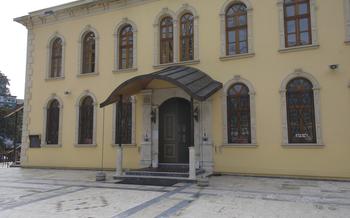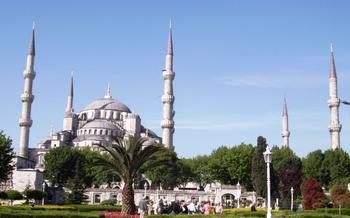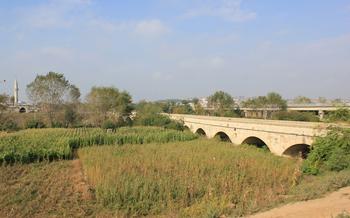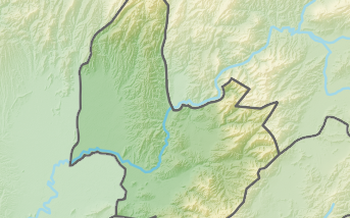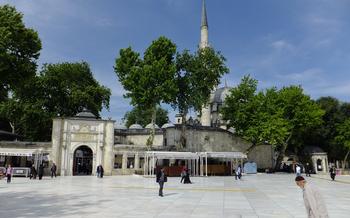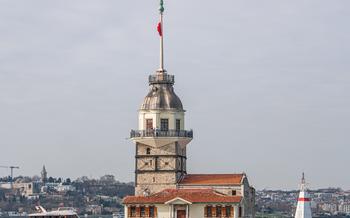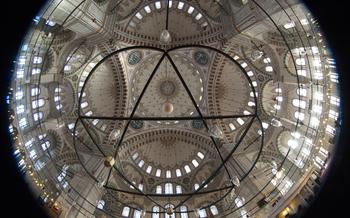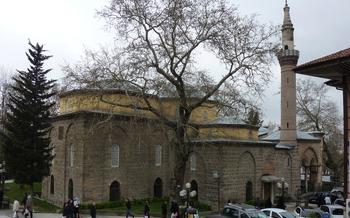
Rahmiye Imperial Mosque
- The Rahmiye Imperial Mosque: A Stunning Masterpiece
- Location and Getting There
- Guided Tours and Information
- Dress Code and Etiquette
- Exploring the Interior
- Mehmet Ali Pasha Tomb
- Sultan Abdülhamid II Tomb
- Courtyard and Gardens
- Historical Significance
- Photography and Videography
- Local Culture and Traditions
- Nearby Attractions
- Accessibility
- Insider Tip: Hidden Gem
The Rahmiye Imperial Mosque: A Stunning Masterpiece
The Rahmiye Imperial Mosque stands as a testament to the grandeur and artistry of the Ottoman Empire. Built in 1834 by Sultan Mahmud II, this magnificent mosque is a masterpiece of Islamic architecture, blending traditional Ottoman elements with European influences. Its striking design, featuring a spacious courtyard, elegant domes, and intricate tilework, has made it a symbol of İzmit's rich cultural heritage.
The mosque holds a significant place in the hearts of the local community, serving as a spiritual center for Muslims in the region. Its serene atmosphere and beautiful surroundings provide a sanctuary for worship, contemplation, and community gatherings. Visitors to the mosque are struck by its grandeur and the sense of peace that permeates the air.
Location and Getting There
The Rahmiye Imperial Mosque is conveniently located in the heart of İzmit, on Atatürk Caddesi, a bustling thoroughfare lined with shops and restaurants. To reach the mosque, you can take advantage of the city's well-connected public transportation system. Several bus lines, including the 54, 55, and 56, stop within walking distance of the mosque. Simply hop on one of these buses and ask the driver to drop you off at the "Rahmiye Camii" stop. If you prefer a more scenic route, consider taking the ferry from Istanbul to İzmit. Upon arrival at the İzmit Ferry Terminal, you can easily walk or take a short taxi ride to the mosque. For those arriving by car, there is limited street parking available in the vicinity of the mosque. However, it is advisable to arrive early to secure a spot, as the area can get quite crowded during peak tourist season.
Insider Tip: To avoid the hassle of finding parking, consider visiting the mosque during the early morning or late afternoon hours when there are fewer visitors. This will allow you to fully appreciate the tranquility and serenity of the mosque without the crowds.
Guided Tours and Information
The Rahmiye Imperial Mosque offers guided tours in various languages, providing visitors with a deeper understanding of its history, architecture, and cultural significance. These tours are conducted by knowledgeable and experienced guides who share captivating insights and anecdotes about the mosque.
The cost of guided tours varies depending on the language and group size. Visitors can book their tours in advance through the mosque's official website or by contacting the mosque directly. It's advisable to book in advance, especially during peak tourist season, to secure your spot and avoid any disappointment.
The guided tours typically cover the mosque's main highlights, including the mihrab, the intricate tilework, the calligraphy, and the decorative elements. The guides also provide information about the mosque's role in the community and its historical significance.
Insider Tip: To get the most out of your guided tour, come prepared with questions and engage in discussions with the guide. Don't hesitate to ask for clarifications or additional information to enhance your understanding of this magnificent mosque.
Dress Code and Etiquette
As a visitor to the Rahmiye Imperial Mosque, it is essential to dress respectfully and adhere to the appropriate etiquette. While there is no strict dress code, modest clothing that covers your shoulders and knees is recommended. For women, a headscarf is required to enter the mosque. These can be provided at the entrance if needed.
When inside the mosque, maintain a respectful demeanor and avoid loud talking or disruptive behavior. Remember that this is a place of worship, and silence and contemplation are encouraged. Follow any instructions or guidelines provided by the mosque staff or volunteers.
To blend in with the locals, observe their behavior and follow their lead. This will help you navigate the mosque respectfully and avoid any cultural misunderstandings. By showing respect for the local customs and traditions, you can enhance your overall experience and contribute to a harmonious atmosphere within the mosque.
Exploring the Interior
Adorned with intricate tilework, calligraphy, and decorative elements, the interior of the Rahmiye Imperial Mosque is a testament to the artistry and craftsmanship of the Ottoman era. The mihrab, a niche indicating the direction of Mecca, is adorned with exquisite tilework and intricate carvings. The pulpit, from which the imam delivers sermons, is an impressive work of art, showcasing intricate woodwork and mother-of-pearl inlay. The serene atmosphere and spiritual significance of the interior create a sense of tranquility and reverence.
As you step inside, take a moment to admire the intricate details and craftsmanship that adorn every corner of the mosque. The sunlight filtering through the stained-glass windows casts a warm glow, illuminating the vibrant colors and patterns of the tiles. Capture the beauty of the interior with your camera, but be mindful of the sanctity of the space and avoid using flash photography. Find a quiet spot to sit and soak in the serene atmosphere, allowing the beauty of the surroundings to wash over you.
Mehmet Ali Pasha Tomb
Within the hallowed grounds of the Rahmiye Imperial Mosque lies the final resting place of a legendary figure in Turkish history—Mehmet Ali Pasha, a man who left an indelible mark on the nation's destiny. Born in Kavala, Greece, in 1769, Mehmet Ali Pasha rose to prominence as a military commander and statesman during the tumultuous years of the Ottoman Empire. His unwavering loyalty and exceptional leadership skills earned him the title of Wāli (Governor) of Egypt, where he established a semi-autonomous state that rivaled the power of the Sultan himself.
Mehmet Ali Pasha's tomb stands as a testament to his remarkable life and achievements. Situated within the mosque complex, the tomb exudes an aura of grandeur and historical significance. Its intricate architecture and decorative elements reflect the opulence and artistry of the Ottoman era. Visitors can't help but be captivated by the intricate tilework, calligraphy, and carvings that adorn the tomb, each detail narrating a chapter in the Pasha's extraordinary journey.
As you pay your respects at Mehmet Ali Pasha's tomb, take a moment to reflect on his contributions to the modernization of Egypt. His visionary reforms in agriculture, industry, and education laid the foundation for Egypt's emergence as a regional power. His legacy extends far beyond the borders of his adopted homeland, as his influence and ideas continue to shape the course of history in the Middle East and beyond.
Insider tip: To fully appreciate Mehmet Ali Pasha's impact on Turkish history, delve into the fascinating exhibits at the Mehmet Ali Pasha Museum, located in Kavala, Greece, his birthplace. Through artifacts, documents, and interactive displays, the museum offers a comprehensive insight into the life and times of this extraordinary figure.
Sultan Abdülhamid II Tomb
Within the Rahmiye Imperial Mosque lies the final resting place of Sultan Abdülhamid II, a pivotal figure in Turkish history. As the 34th sultan of the Ottoman Empire, Abdülhamid II reigned for over 30 years and left a lasting legacy. His tomb, situated within the mosque complex, serves as a testament to his contributions and significance.
The tomb, like the mosque itself, showcases intricate architectural details and historical significance. Its design reflects the sultan's reign, which witnessed both internal reforms and external challenges. The tomb's location within the mosque complex emphasizes the ruler's connection to the religious and political spheres of the Ottoman Empire.
To truly appreciate the historical significance of Sultan Abdülhamid II's tomb, learn about the sultan's life and accomplishments before your visit. Immerse yourself in his efforts to modernize the empire, his role in shaping foreign policy, and the challenges he faced during his reign. Understanding his legacy will deepen your appreciation for this site.
Courtyard and Gardens
Surrounding the Rahmiye Imperial Mosque is a tranquil courtyard that exudes an air of serenity. Step inside and be greeted by lush, well-maintained gardens and landscaping. The courtyard provides a welcoming space for visitors to relax and soak in the mosque's tranquil atmosphere.
In the courtyard, you'll find ablution fountains, an essential part of the Muslim purification ritual before prayer. These fountains hold cultural and religious significance, highlighting the importance of cleanliness and purity in Islamic tradition.
Insider tip: Venture into the courtyard during twilight hours. As the sun dips below the horizon, the courtyard transforms into a magical space, with the mosque's silhouette casting long shadows and the gardens illuminated by a soft glow. It's a perfect time for peaceful reflection and capturing breathtaking photos.
Historical Significance
The Rahmiye Imperial Mosque holds immense historical significance as a symbol of the Ottoman Empire's architectural prowess and religious devotion. Built during the reign of Sultan Abdülhamid II, the mosque stands as a testament to the empire's commitment to preserving Islamic traditions while embracing modern architectural influences. Its construction marked a significant period of growth and development for the city of Izmit, solidifying its position as a cultural and religious hub.
As a living testament to the Ottoman era, the mosque has witnessed numerous historical events. It served as a venue for important religious ceremonies, political gatherings, and celebrations. Its majestic presence has been a constant backdrop to the changing tides of history, from the empire's rise to its eventual decline.
Within its walls, the mosque has hosted countless prayers, recitations, and sermons, fostering a deep sense of community and devotion among the worshippers. It has been a place of refuge and solace, offering spiritual guidance and comfort to generations of believers.
To fully appreciate the mosque's historical significance, visitors are encouraged to learn about the Ottoman Empire's rich history, its architectural achievements, and the role of religion in shaping the empire's identity. By delving into the mosque's past, they gain a deeper understanding of its enduring legacy and its profound impact on Turkey's cultural and spiritual heritage.
Photography and Videography
The Rahmiye Imperial Mosque welcomes photography and videography enthusiasts to capture the beauty and grandeur of its interiors and exteriors. However, it is essential to adhere to certain guidelines to ensure respect for the sacred space and the privacy of other visitors.
Photography and videography are permitted in designated areas within the mosque, excluding prayer halls and restricted zones. These areas are clearly marked to guide visitors and ensure they do not disturb ongoing religious activities.
When taking photos or videos, visitors are encouraged to be mindful of their surroundings and avoid using flash or tripods that may disrupt the serenity of the mosque. It is also important to be respectful of other visitors, asking for permission before photographing individuals or groups.
To capture the best shots, consider visiting the mosque during golden hour, when the soft, warm light illuminates the mosque's intricate details. Experiment with different angles and perspectives to showcase the mosque's architectural wonders, such as its soaring domes, graceful minarets, and colorful tilework.
Insider tip: For a unique perspective, head to the mosque's courtyard and capture the stunning reflection of the mosque in the tranquil pool. This hidden gem offers a picturesque opportunity to immortalize your visit to this architectural masterpiece.
Local Culture and Traditions
The Rahmiye Imperial Mosque holds a profound cultural significance for the people of İzmit. It stands as a testament to their rich heritage and serves as a place of worship, contemplation, and community gathering. Visitors to the mosque are encouraged to embrace the local customs and traditions to fully immerse themselves in the spiritual and cultural tapestry of İzmit.
When interacting with locals, it is essential to exhibit warmth, respect, and a genuine interest in their way of life. The people of İzmit are known for their hospitality and welcoming nature, and they are always eager to share their culture and traditions with respectful visitors.
One important custom to observe is dressing modestly and appropriately when visiting the mosque. Women should cover their hair with a headscarf as a sign of respect for Islamic traditions. Both men and women should avoid wearing revealing or tight-fitting clothing.
Inside the mosque, it is customary to maintain a respectful demeanor and avoid loud conversations or disruptive behavior. Visitors should follow the lead of the locals and observe the peaceful and serene atmosphere that permeates the mosque.
Insider tip: To truly experience the local culture, consider visiting the mosque during one of the five daily prayer times. Witnessing the communal prayers and observing the devotion of the worshippers can provide a deeper understanding of the importance of faith in the lives of the local people.
Nearby Attractions
Surrounding the Rahmiye Imperial Mosque, a plethora of historical and cultural gems await exploration. Delve into the annals of time at the İzmit Museum, where captivating exhibits narrate the city's rich past. Embark on a shopping expedition at the vibrant İzmit Bazaar, where you can haggle for unique souvenirs and immerse yourself in the lively local atmosphere.
For a culinary adventure, savor the delectable delights offered by İzmit's renowned restaurants. Indulge in mouthwatering kebabs, freshly caught seafood, and tantalizing sweets that will tantalize your taste buds.
To craft a well-rounded itinerary, consider venturing beyond the mosque's immediate vicinity. Discover the grandeur of the Kocaeli Castle, a testament to the region's rich history. Explore the serene ambiance of Şelale Park, where cascading waterfalls and lush greenery create a tranquil oasis.
Insider tip: Plan a day trip to the scenic Sapanca Lake, just a short drive from İzmit. Surrounded by picturesque landscapes, the lake offers a variety of outdoor activities, including boating, fishing, and hiking. Embark on a leisurely stroll along the lakeshore promenade, admiring the stunning views and soaking in the tranquility of nature.
Accessibility
The Rahmiye Imperial Mosque is committed to ensuring that all visitors, regardless of their abilities, can fully enjoy and appreciate the mosque's beauty and history. The mosque is equipped with facilities and services to accommodate visitors with disabilities, making it an accessible and welcoming space for everyone.
Wheelchair ramps and designated areas for assistance and support are thoughtfully provided throughout the mosque complex. Visitors with disabilities can easily navigate the mosque's interior, including the main prayer hall, courtyard, and gardens, without encountering any obstacles or barriers.
To ensure a comfortable and inclusive visit, visitors with disabilities are encouraged to contact the mosque's administration in advance. The mosque staff is dedicated to providing any necessary assistance or accommodations to make their visit as smooth and enjoyable as possible. With its commitment to accessibility, the Rahmiye Imperial Mosque welcomes all visitors to experience its architectural wonders and spiritual significance.
Insider tip: For a truly immersive and personalized experience, visitors with disabilities are advised to coordinate their visit with the mosque's administration. The staff can arrange for a dedicated guide or assistant to accompany them throughout the mosque, providing detailed explanations and assistance as needed. This special service ensures that visitors with disabilities can fully appreciate the mosque's history, architecture, and spiritual significance.
Insider Tip: Hidden Gem
Within the Rahmiye Imperial Mosque lies a hidden gem that often goes unnoticed by visitors. Tucked away in a secluded corner of the courtyard is a small, unassuming fountain known as the "Fountain of Wishes." According to local legend, if you make a wish and toss a coin into the fountain, your wish will be granted. Whether you believe in the legend or not, taking a moment to pause by the fountain and reflect on your hopes and dreams adds a touch of magic to your visit to this magnificent mosque.


